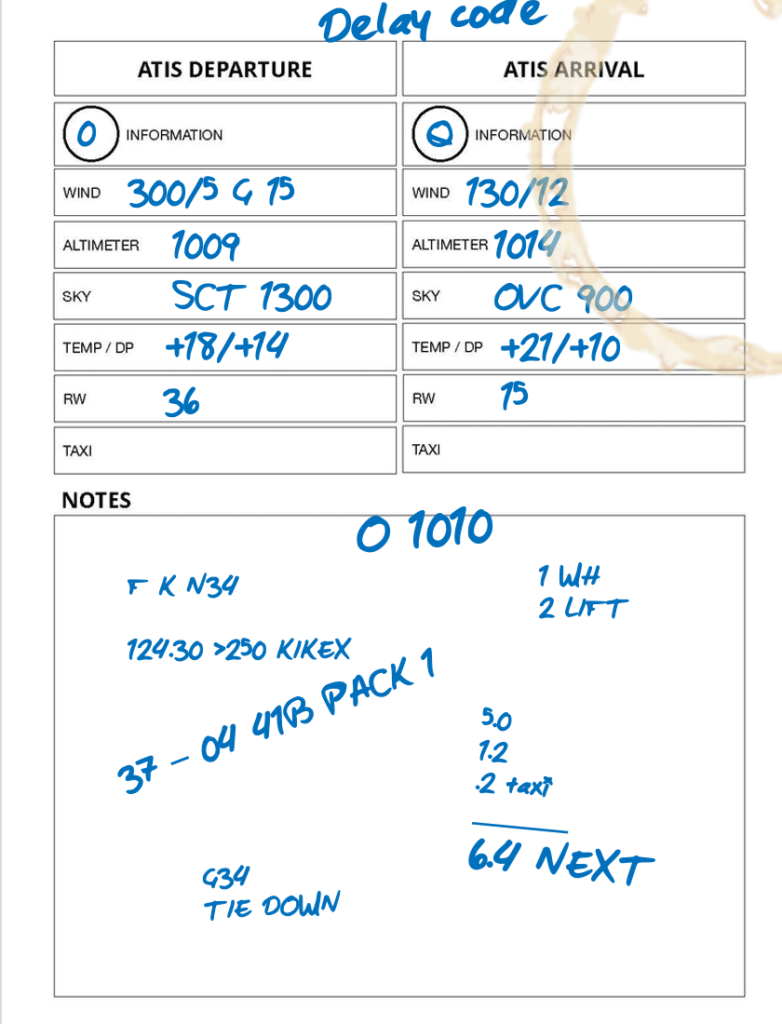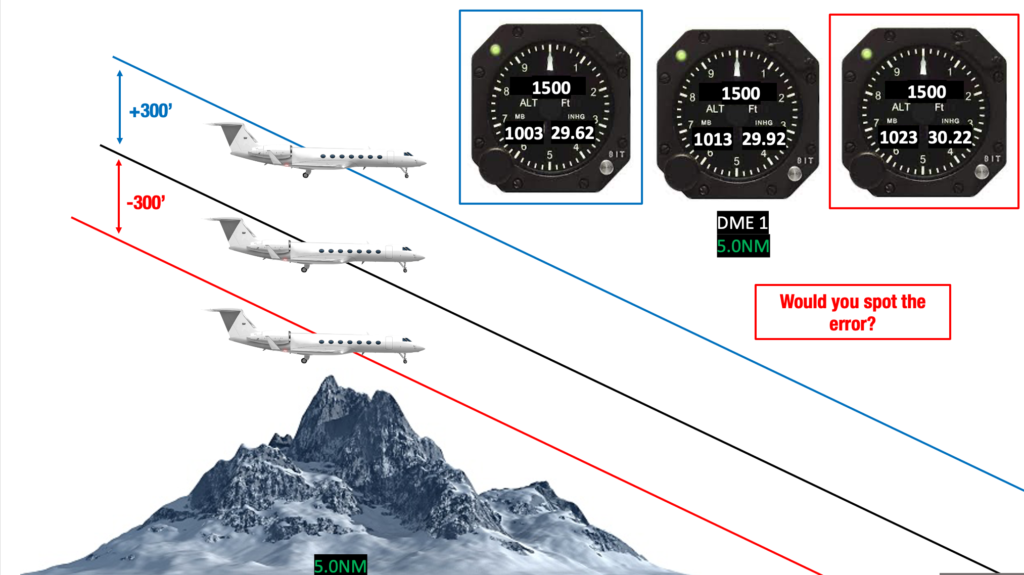Beware Below: New ICAO Guidance on QNH Errors (original) (raw)
Key Points
- Following recent incidents where erroneous altimeter settings impacted safety on some approaches, ICAO has published a Bulletin with a list of recommendations to help prevent errors.
- Approaches affected: VOR, NDB, LOC, RNP, and RNP (AR).
- QNH errors happen due to: bogus data, over-reliance on voice to communicate safety critical information, pilot workload.
- Recommendations: consider other approaches, raise your minima, stick to SOPs and cross-check the QNH, talk to ATC.
A Wolf in Sheep’s Clothing…
![]() An innocuous QNH error can easily place your aircraft hundreds of feet below profile in the final approach segment of a non-precision approach. And there may be very few signs – save for our eyeballs, our radio altimeter, or ultimately our EGPWS.
An innocuous QNH error can easily place your aircraft hundreds of feet below profile in the final approach segment of a non-precision approach. And there may be very few signs – save for our eyeballs, our radio altimeter, or ultimately our EGPWS.
And perhaps the approaches most vulnerable to this threat are those which use BARO-VNAV – in other words, the use of our aircraft’s barometric altitude information to compute the aircraft’s vertical guidance.
The problem is that to fly these approaches safely, our altimeters must be accurate. That entirely depends on pilots setting the correct QNH. It is a simple task riddled with potential for insidious errors – something that no pilot (or controller) is immune to.
Which is why ICAO recently published a new Ops Bulletin on this very problem. They can’t fix it, but they can help mitigate it. Here’s a run-down on what they had to say.
Risky Business
If you’re reading this, chances are you have a reasonable idea about how an altimeter works. In the most basic sense, we calibrate these pressure-sensitive devices to provide an altitude above whatever datum we need them for – in most cases, sea level.
This essentially creates potential for two errors:
- Temperature – although this is less of an issue, because we can anticipate and correct for it.
- A mis-set – or in other words, rubbish in rubbish out. The altimeter doesn’t know if it’s telling you lies. In the same sense that a conventional clock doesn’t know that it’s wrong – it just runs from whatever time you set it to. The consequences of this type of error are far worse.
Final Approach
ICAO’s Bulletin focuses on the final approach (inside the FAF) simply because this is where altimeter errors become most critical.
In this segment, ICAO-compliant procedures only guarantee a smidge less than 300 feet of obstacle clearance (ICAO Doc 8168 Vol II if you’re feeling bold). Interestingly, this almost perfectly correlates to an altimeter error of 10hPa…
Are you sure that 1023 QNH you just heard on that scratchy ATIS wasn’t actually 1013?
…it’s easy to see how critical errors can become. Like the example below:
Which approaches are affected?
It can be easy to get lost in the sea of acronyms out there. So let’s keep it simple:
Not vulnerable: ILS, GLS, and RNP to LPV minima. In other words, approaches that do not rely on barometric altitude to fly the correct profile. One gotcha tho – DA is still based on your altimeter. You may therefore go around early or late with an incorrect QNH but the profile itself will still be correct.
Vulnerable: Everything else – including VOR, NDB, LOC, RNP, and RNP (AR).
Why are QNH errors happening?
ICAO has some ideas:
Bogus Data: This may be incorrect information supplied by a met service provider, corrupt hardware on the ground or even by assuming area QNH will be close enough to airport QNH.
**Chinese Whispers:**Don’t underestimate the power of what you think you heard. This can happen anytime we are relying on voice to communicate safety critical information. It’s not just pilots either – ATC may not pick up that your read-back was incorrect. If you fly internationally, the language barrier can also be a challenge. Even domestically we form habits of talking at speed on the radio. If there is any doubt, use the phrase “Say Again Slowly.”
Workload: Have you ever been in this boat? You’re passing through transition, changing to an approach frequency, slowing to 250kts, securing the cabin and trying to run an approach checklist….all at the same time. Depending on where the transition level is (for example, FL110 in Australia) it can clash with your other flight deck duties. Crew confusion, miscommunication and even finger trouble can come into play here.
What can we do about it?
Consider other approaches: iI there’s an ILS or similar available and conditions are poor, consider using it instead.
Think about minimas: ICAO suggest raising your minima particularly if you are unfamiliar with an approach type.
Stick to the SOPs: and cross check. Treat QNH like that stove you think you left on every time you leave for a multi-day trip. Become paranoid and find that error. Cross-check the QNH across multiple sources – at least two independent ones for each and every approach.
Don’t forget to ask yourself – is it sensible? A good way to cross check this is by comparing the ATIS QNH to the TAF or METAR QNH. If there is any doubt, confirm it with ATC.
Be especially suspicious of anything hand-written: If you’ve obtained a QNH by voice, make sure you have both independently heard it.

Be careful with anything hand written. Is our arrival info Q 1014 or could it be O 1019?
Don’t forget other sensibility checks: Terrain permitting, your radio altimeter may give you an early clue that all is not right – especially if you’re over flat terrain or water.
ICAO also suggests that ATCOs and ANSPs have a role to play too: It’s little beyond the scope of this article, but you can find that info in the very same bulletin.
Have a story to tell?
Please share it with us in confidence, we’d love to learn from it. You can reach us on team@ops.group.
And if you’re interested in all things safety, don’t forget about Danger Club. These OPSGROUP hosted sessions are about getting together as humans in a safe space and talking about danger. You can read more about DC here.
More on the topic:
*** More: Has Russia stopped playing me-trics on us?** *** More: Big change: Russia finally moving to QNH**
More reading:
*** Latest: US Pre-Clearance: How does it work?** *** Latest: 2025 North Atlantic Plotting & Planning Chart** *** Latest: Member Meetup – NAT Special: Nov 6, 1500 UTC** *** Safe Airspace: Risk Database** *** Weekly Ops Bulletin: Subscribe** *** Membership plans: Why join OPSGROUP?**
